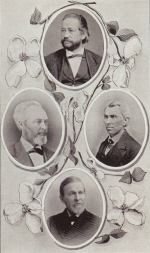Founding: 1859-1878
“And may the men be always ready, as the years come and go, to carry on, with widening reach and heightened power, the work we sought to do, and did begin!” John Broadus, Memoir of James P. Boyce
That work memorialized by Broadus began formally in 1859 in Greenville, South Carolina. The
Southern Baptist Theological Seminary opened that fall with a class of twenty-six students.
Southern Baptists like Charleston pastor Basil Manly, Sr., had long sought a seminary of the South that would train ministers. When South Carolina Baptists met in Greenville in 1856 at their annual gathering, James P. Boyce, a professor of theology at Furman University, challenged attendees to finance a Seminary. Southern Baptists answered the call, pledging one hundred thousand dollars toward the venture. Boyce then called other Southern Baptists to pledge another hundred thousand dollars. The momentum begun, attendees of the 1857 Education Convention in Louisville formally approved the motion to begin The Southern Baptist Theological Seminary. One year later, Convention members selected the Seminary faculty.
The first faculty possessed strong minds and devoted faith. James P. Boyce, a native of Charleston, South Carolina, finished seventh in his undergraduate class at Brown University and later earned the Master of Arts degree from Brown. John A. Broadus began teaching classics at the University of Virginia just a year after he earned his master’s degree from the same. Basil Manly, Jr., Boyce’s childhood friend, graduated as valedictorian of the University of Alabama and later earned an M.A. from Princeton Seminary. William Williams, the fourth founder, successfully completed studies at the University of Georgia and the Harvard School of Law.
Boyce gave Southern its institutional vision. In his inaugural address to the Furman community in 1856, Boyce called for “Three Changes in Theological Education.” First, the seminary ought to provide opportunity for theological study for men without college degrees; second, that the curriculum should also meet the needs of the most advanced students; and third, that the faculty should solemnly pledge their commitment to a Scriptural “abstract of principles” to guard truth and counter heresy. The 1858 Education Convention voted to make this vision a reality.
Boyce coupled his educational philosophy with practical wisdom. He and Broadus agreed with southern educator Thomas Curtis, who said that most seminaries wrongly prioritized “the three b’s of institutions of learning: bricks, books, and brains.” Many institutions, said Curtis, “spend all their money for bricks, have nothing for books, and must take such brains as they can pick up.” (1) Boyce was determined not to repeat this mistake. Instead of buying property, he located the school in the old meetinghouse of the First Baptist Church of Greenville, which granted its use rent-free. The seminary commenced with two classrooms and a library of two thousand volumes.
Southern offered its students a course of study organized into eight areas: Biblical Introduction, Interpretation of the Old and New Testaments, Systematic Theology, Polemic Theology, Homiletics, Church History, and Church Government. In later years, the seminary added a class focused on study of the English Bible, the first of its kind in an American seminary. Passing classes of any kind was no easy feat at Southern. Examinations often centered in recitation of memorized material and frequently lasted for ten hours.
Just two years after Southern’s founding, the Civil War swept over the nation, taking with it the student body of Southern. The seminary drew only twenty students in 1861. Southern closed in the fall of 1862 for the remainder of the War. Its endowment was lost and its survival in doubt. But the faculty pledged themselves to the seminary. Broadus spoke for them all: “Suppose we quietly agree that the seminary may die, but we’ll die first.” (2)
In order to secure a new endowment, the seminary would have to relocate. Boyce and the trustees considered Chattanooga, Atlanta, Memphis, and Louisville. They chose Louisville because Louisville’s civic leaders promised strong support and Kentucky Baptists offered to pay the lion’s share of the endowment. When the seminary moved to Kentucky in 1877, a remarkable 89 students registered for classes, proving the wisdom of the move.
(1) Mueller, A History of Southern Baptist Theological Seminary, 15.
(2) Broadus, Memoir of James P. Boyce, 239.
Any historical record of the founders of the Southern Baptist Convention, and The Southern Baptist Theological Seminary, is incomplete without an honest telling of their complicity in American slavery and racism. For more on that story, read here.



